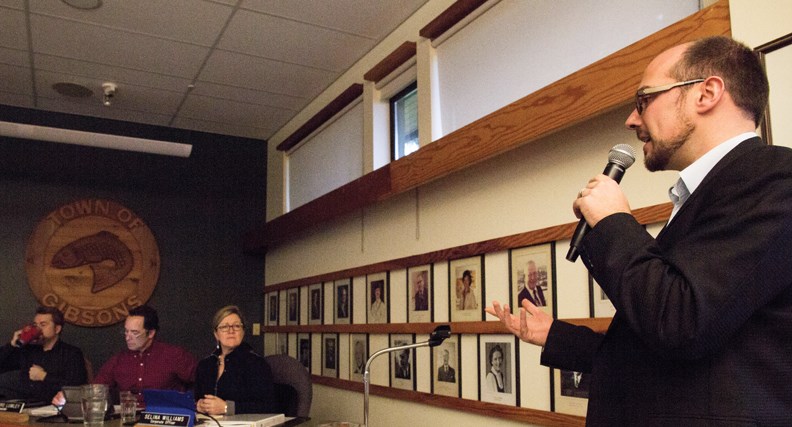Gibsons council is in the process of updating the Town’s development cost charge (DCC) bylaw. James Klukas, local government advisor at Urban Systems, reported to committee of the whole on Dec. 15 with a review of the Town’s proposed DCC program.
Klukas explained in his review that the total recoverable costs for the Town – money the Town collects from developers for the cost of infrastructure projects – has decreased by seven per cent since the last update to the DCC bylaw in 2007, while the rates being charged to developers have increased by about five per cent for commercial, industrial and residential developments.
“Across the board for the residential categories, what we would be looking at is essentially a five per cent increase in DCCs,” Klukas said. “Although the DCC recoverable has gone down, the rates are increasing slightly. That’s reflective of not including as much projected growth in the community.”
Drainage rates for commercial and industrial developments are both decreased by 20 per cent. Commercial drainage rates are reduced from just under $135,000 in 2007 to just over $108,000, while industrial drainage rates went down from a little more than $84,000 to just over $67,500 in the proposed DCC bylaw update.
Transportation, water and sewer rates are up by 13 per cent for commercial developments – $78.04 per square metre in 2007 increased to $88.63 – and six per cent for industrial developments, which increased from $35.85 per square metre in 2007 to $38.03 in the proposed DCC bylaw update.
“Those increases for commercial/industrial transportation, water and sewer are being offset by the decrease on the drainage DCC,” Klukas said. “We essentially see this as a good news story after 2007 to the year – now 2016 upcoming – we’d be looking at a five per cent increase overall in DCC rates.”
DCCs are comprised of four areas of the Town’s infrastructure: water, sanitary, drainage and transportation.
A little over $35.9 million was identified as total recoverable program costs for all infrastructure categories in the proposed 2015 DCC bylaw update. This is approximately seven per cent less than the total recoverable program costs (identified at just over $38.5 million) in the last comprehensive review of the DCC bylaw done in 2007.
Recoverable costs for water and drainage have decreased significantly by 29 and 21 per cent respectively. Recoverable costs for water have decreased by a little over $1.5 million – from close to $6 million in 2007 to just over $4 million proposed in 2015. Recoverable costs for drainage decreased from over $8 million in 2007 to a little over $6.5 million proposed in 2015.
Director of engineering Dave Newman attributed these decreases partly to projects that have been completed since 2007. The completed water infrastructure projects in Gibsons have been valued at just over $1.5 million, while completed drainage projects have been valued at $537,000.
Newman also attributed these decreases to the exclusion of Gospel Rock in the proposed 2015 DCC bylaw update.
“On all of the DCC categories, we eliminated Gospel Rock,” Newman said. “The reason for that was that at the time of the previous DCC bylaw, Gospel Rock was a little bit more front and centre. We had a developer that was actively pursuing development in the Gospel Rock area. … Since that time the largest parcel in the Gospel Rock area has changed hands more than once. We’ve had no indication of pending development.”
Recoverable costs for sanitary projects have increased by only about $12,000 – from just over $4,875,000 in 2007 to just over $4,887,000 proposed in 2015 – which resulted in a less than one per cent change. Transportation increased by approximately four per cent – from just over $19.5 million in 2007 to a little more than $20 million proposed in 2015.
“The development potential that these costs are spread out over has also decreased,” Newman said. “From 10,000 population in the current [2007] bylaw to 8,600 in the proposed [2015] bylaw – due to the exclusion of Gospel Rock – resulting in a five to six per cent increase in rates for residential development.”
The proposed DCC bylaw is based on a population growth for the Town from its current population of 4,600 to an estimated maximum population of 8,600. At a growth rate of 1.2 per cent, it is estimated that Gibsons will have a population of 8,600 in 50 years. At a growth rate of two per cent, it is estimated the Town will reach this population in 30 years.
The proposed DCC bylaw is scheduled to receive second reading at the next council meeting on Jan. 12. Following third reading, the proposed bylaw will need ministerial approval before it can be adopted.



